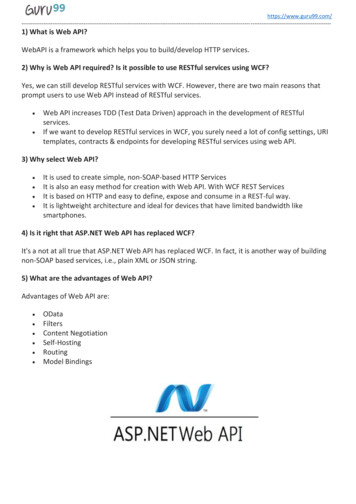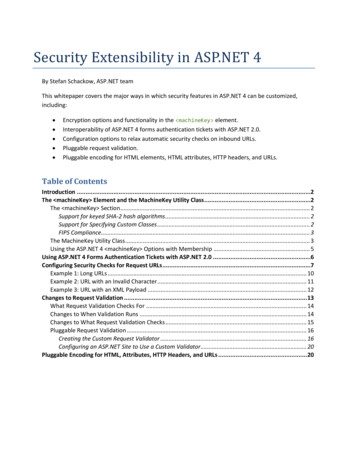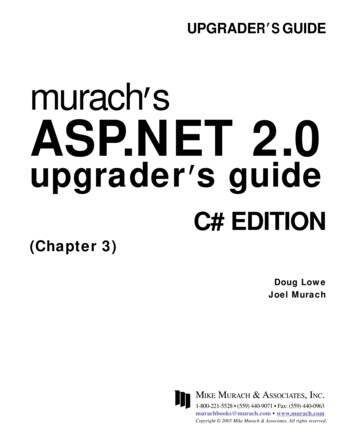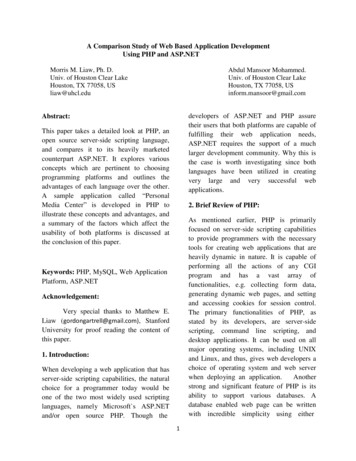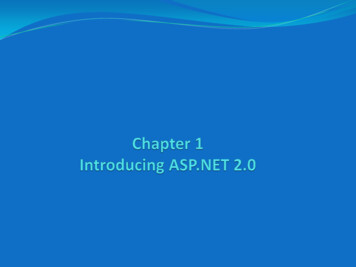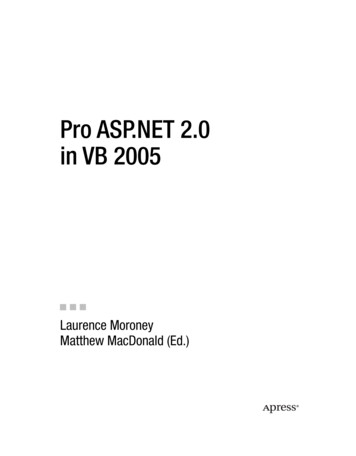
Transcription
5637ch00FM.qxd12/23/0511:03 AMPage iPro ASP.NET 2.0in VB 2005Laurence MoroneyMatthew MacDonald (Ed.)
5637ch00FM.qxd12/23/0511:03 AMPage iiPro ASP.NET 2.0 in VB 2005Copyright 2006 by Laurence Moroney, Matthew MacDonald (Ed.), K. Scott Allen, James Avery, RussBasiura, Mike Batongbacal, Marco Bellinaso, Matt Butler, Andreas Eide, Daniel Cazzulino, Michael Clark,Richard Conway, Robert Eisenberg, Brady Gaster, James Greenwood, Kevin Hoffman, Erik Johansson,Angelo Kastroulis, Dan Kent, Sitaraman Lakshminarayanan, Don Lee, Christopher Miller, Matt Milner,Jan Narkiewicz, Matt Odhner, Ryan O’Keefe, Andrew Reid, Matthew Reynolds, Enrico Sabbadin, Bill Sempf,Doug Seven, Srinivasa Sivkumar, Thiru Thangarathinam, Doug ThewsAll rights reserved. No part of this work may be reproduced or transmitted in any form or by any means,electronic or mechanical, including photocopying, recording, or by any information storage or retrievalsystem, without the prior written permission of the copyright owner and the publisher.ISBN-13 (pbk): 978-1-59059-563-3ISBN-10 (pbk): 1-59059-563-7Library of Congress Cataloging-in-Publication data is available upon request.Printed and bound in the United States of America 9 8 7 6 5 4 3 2 1Trademarked names may appear in this book. Rather than use a trademark symbol with every occurrenceof a trademarked name, we use the names only in an editorial fashion and to the benefit of the trademarkowner, with no intention of infringement of the trademark.Lead Editor: Tony DavisTechnical Reviewer: Andy OlsenEditorial Board: Steve Anglin, Dan Appleman, Ewan Buckingham, Gary Cornell, Tony Davis, Jason Gilmore,Jonathan Hassell, Chris Mills, Dominic Shakeshaft, Jim SumserProject Manager: Richard Dal PortoCopy Edit Manager: Nicole LeClercCopy Editor: Kim WimpsettAssistant Production Director: Kari Brooks-CoponyProduction Editor: Linda MarousekCompositor and Artist: Kinetic Publishing Services, LLCProofreaders: Linda Seifert and Nancy SixsmithIndexer: Broccoli Information ManagementCover Designer: Kurt KramesManufacturing Director: Tom DebolskiDistributed to the book trade worldwide by Springer-Verlag New York, Inc., 233 Spring Street, 6th Floor,New York, NY 10013. Phone 1-800-SPRINGER, fax 201-348-4505, e-mail orders-ny@springer-sbm.com, orvisit http://www.springeronline.com.For information on translations, please contact Apress directly at 2560 Ninth Street, Suite 219, Berkeley, CA94710. Phone 510-549-5930, fax 510-549-5939, e-mail info@apress.com, or visit http://www.apress.com.The information in this book is distributed on an “as is” basis, without warranty. Although every precautionhas been taken in the preparation of this work, neither the author(s) nor Apress shall have any liability toany person or entity with respect to any loss or damage caused or alleged to be caused directly or indirectlyby the information contained in this work.The source code for this book is available to readers at http://www.apress.com in the Source Code section.You will need to answer questions pertaining to this book in order to successfully download the code.
5637ch01.qxd12/16/052:18 PMCHAPTERPage 31 Introducing ASP.NETWhen Microsoft created .NET, it wasn’t just dreaming about the future—it was also worryingabout the headaches and limitations of the current generation of web development technologies.Before you get started with ASP.NET 2.0, it helps to take a step back and consider these problems.You’ll then understand the solution that .NET offers.In this chapter you’ll consider the history of web development leading up to ASP.NET, takea whirlwind tour of the most significant features of .NET, and preview the core changes in ASP.NET 2.0.If you’re new to ASP.NET, this chapter will quickly get you up to speed. On the other hand, if you’rea seasoned .NET developer, you have two choices. Your first option is to read this chapter for a briskreview of where we are today. Alternatively, you can skip to the section “ASP.NET 2.0: The Story Continues” to preview what ASP.NET 2.0 has in store.The Evolution of Web DevelopmentMore than ten years ago, Tim Berners-Lee performed the first transmission across HTTP (HypertextTransfer Protocol). Since then, HTTP has become exponentially more popular, expanding beyonda small group of computer-science visionaries to the personal and business sectors. Today, it’s almosta household term.When HTTP was first established, developers faced the challenge of designing applicationsthat could discover and interact with each other. To help meet these challenges, standards such asHTML (Hypertext Markup Language) and XML (Extensible Markup Language) were created. HTMLestablished a simple language that could describe how to display rich documents on virtually anycomputer platform. XML created a set of rules for building platform-neutral data formats that different applications could use to exchange information. These standards guaranteed that the Webcould be used by anyone, located anywhere, using any type of computing system.At the same time, software vendors faced their own challenges. They needed to develop notonly language and programming tools that could integrate with the Web but also entire frameworksthat would allow developers to architect, develop, and deploy these applications easily. Major softwarevendors including IBM, Sun Microsystems, and Microsoft rushed to meet this need with a host ofproducts.ASP.NET 1.0 opened a new chapter in this ongoing arms race. With .NET, Microsoft created anintegrated suite of components that combines the building blocks of the Web—markup languagesand HTTP—with proven object-oriented methodology.3
5637ch01.qxd412/16/052:18 PMPage 4CHAPTER 1 INTRODUCING ASP.NETThe Development World Before ASP.NETOlder technologies for server-based web applications rely on scripting languages or proprietary tagging conventions. Most of these web development models just provide clumsy hooks that allow youto trigger applications or run components on the server. They don’t provide a modern, integratedframework for web programming.Overall, most of the web development frameworks that were created before ASP.NET fall intoone of two categories: Scripts that are interpreted by a server-side resource Separate, tiny applications that are executed by server-side callsClassic ASP (Active Server Pages, the version of ASP that predates ASP.NET) and ColdFusion fallinto the first category. You, the developer, are responsible for creating a script file that containsembedded code. The script file is examined by another component, which alternates between rendering ordinary HTML and executing your embedded code. If you’ve created ASP applications before,you probably know that scripted applications usually execute at a much slower rate than compiledapplications. Additionally, scripted platforms introduce other problems, such as the lack of abilityto control security settings and inefficient resource usage.The second approach—used widely by, for example, Perl over CGI (Common Gateway Interface)—yields an entirely different set of problems. In these frameworks, the web server launches a separateapplication to handle the client’s request. That application executes its code and dynamically createsthe HTML that should be sent back to the client. Though these applications execute faster than theirscripted counterparts, they tend to require much more memory. The key problem with this sort ofapproach is that the web server needs to create a separate instance of the application for each clientrequest. This model makes these applications much less scalable in environments with large numbers of simultaneous users, unless you code carefully. This type of application can also be quitedifficult to write, debug, and integrate with other components.ASP.NET is far more than a simple evolution of either type of application. Instead, it breaks thetrend with a whole new development model. The difference is that ASP.NET is deeply integratedwith its underlying framework. ASP.NET is not an extension or modification to the .NET Frameworkwith loosely coupled hooks into the functionality it provides. Instead, ASP.NET is a portion of the.NET Framework that’s managed by the .NET runtime. In essence, ASP.NET blurs the line betweenapplication development and web development by extending the tools and technologies previouslymonopolized by desktop developers into the web development world.What’s Wrong with Classic ASP?If you’ve programmed only with classic ASP before, you might wonder why Microsoft changedeverything with ASP.NET. Learning a whole new framework isn’t trivial, and .NET introduces a slewof concepts and can pose some serious stumbling blocks.Overall, classic ASP is a solid tool for developing web applications using Microsoft technologies.However, as with most development models, ASP solves some problems but also raises a few of itsown. The following sections outline these problems.Spaghetti CodeIf you’ve created applications with ASP, you’ve probably seen lengthy pages that contain server-sidescript code intermingled with HTML. Consider the following example, which fills an HTML dropdown list with the results of a database query to get author details from the Pubs database in SQLServer:
5637ch01.qxd12/16/052:18 PMPage 5CHAPTER 1 INTRODUCING ASP.NET %Set dbConn Server.CreateObject("ADODB.Connection")Set rs Server.CreateObject("ADODB.Recordset")dbConn.Open "PROVIDER SQLOLEDB;DATA SOURCE (local);DATABASE Pubs;User sa;Password sa"% select name "cboAuthors" %rs.Open "SELECT * FROM Authors", dbConn, 3, 3Do While Not rs.EOF% option value " % rs("au id")% " % rs("au lname") & ", " &rs("au fname")% /option %rs.MoveNextLoop% /select This example needs an unimpressive 16 lines of code to generate one simple HTML control.But what’s worse is the way this style of coding diminishes application performance because it mingles HTML and script. When this page is processed by the ASP ISAPI (Internet Server ApplicationProgramming Interface) extension that runs on the web server, the scripting engine needs to switchon and off multiple times just to handle this single request. This increases the amount of time neededto process the whole page and send it to the client.Furthermore, web pages written in this style can easily grow to unmanageable lengths. If youadd your own custom COM components to the puzzle (which are needed to supply functionality ASPcan’t provide) and aren’t careful about how you design your application, the management nightmaregrows. The bottom line is that no matter what approach you take, ASP code tends to become beastly,long, and incredibly difficult to debug—if you can even get ASP debugging working in your environment at all.In ASP.NET, these problems don’t exist. Web pages are written with traditional object-orientedconcepts in mind. Your web pages contain controls that can be programmed against in a way similar to desktop applications. This means you don’t need to combine a jumble of HTML markup andinline code. If you opt to use the code-behind approach when creating ASP.NET pages, the code andpresentation are actually placed in two different files; simplifies code maintenance and allows youto separate the task of web-page design from the heavy-duty work of web coding.Script LanguagesAt the time of its creation, ASP seemed like a perfect solution for desktop developers who were moving to the world of the Web. Rather than requiring programmers to learn a completely new languageor methodology, ASP allowed developers to use familiar languages such as VBScript on a server-basedprogramming platform. By leveraging the already-popular COM (Component Object Model) programming model as a backbone, these scripting languages also acted as a convenient vehicle foraccessing server components and resources. But even though ASP was easy to understand fordevelopers who were already skilled with scripting languages such as VBScript, this familiarity camewith a price.Performance wasn’t the only problem. Every object or variable used in a classic ASP script iscreated as a variant data type. As most Visual Basic programmers know, variant data types are weaklytyped. They require larger amounts of memory, are late-bound, and result in slower performance.Additionally, the compiler and development tools can’t identify them at design time. This made it allbut impossible to create a truly integrated IDE (integrated development environment) that could provide ASP programmers with anything like the powerful debugging, IntelliSense, and error checking5
5637ch01.qxd612/16/052:18 PMPage 6CHAPTER 1 INTRODUCING ASP.NETfound in Visual Basic and Visual C . And without debugging tools, ASP programmers were hardpressed to troubleshoot the problems in their scripts.ASP.NET circumvents all these problems. For starters, ASP.NET web pages (and web services)are executed within the CLR (common language runtime), so they can be authored in any languagethat has a CLR-compliant compiler. No longer are you limited to using VBScript or JavaScript—instead, you can use modern object-oriented languages such as Visual Basic and C#.It’s also important to note that ASP.NET pages are not interpreted but are instead compiled intoassemblies (the .NET term for any unit of compiled code). This is one of the most significant enhancements to Microsoft’s web development model in ASP.NET 2.0. What actually happens behind the scenesis revolutionary. Even if you create your code in Notepad and copy it directly to a virtual directoryon a web server, the application is dynamically compiled as soon as a client accesses it (in previousversions you had to precompile the application into a DLL), and it is cached for future requests. Ifany of the files are modified after this compilation process, the application is recompiled automatically the next time a client requests it.The Death of COMThough Microsoft claims undying support for COM, the technology that underlies the Windowsoperating system, and almost every application that runs on it, it’s obvious that .NET is the start ofa new path for modern development. Future versions of the Windows operating system (includingthe elusive Longhorn) will integrate the .NET Framework more deeply into the operating systemkernel, making it the first-class language of all application development. And as COM applicationswane in popularity and applications are converted to .NET, classic ASP will become a thing of thepast. Even though .NET includes robust support for COM interoperability, the fact remains thatclassic ASP applications have no real place in a .NET world.ASP.NET 1.0Microsoft developers have described ASP.NET as their chance to “hit the reset button” and start fromscratch with an entirely new, more modern development model. The traditional concepts involvedin creating web applications still hold true in the .NET world. Each web application consists of webpages. You can render rich HTML and even use JavaScript, create components that encapsulateprogramming logic, and tweak and tune your applications using configuration settings. However,behind the scenes ASP.NET works quite differently than traditional scripting technologies such asclassic ASP or PHP (PHP: Hypertext Preprocessor). It’s also much more ambitious than JSP (JavaServer Pages).Some of the differences between ASP.NET and earlier web development platforms include thefollowing: ASP.NET features a completely object-oriented programming model, which includes an eventdriven, control-based architecture that encourages code encapsulation and code reuse. ASP.NET gives you the ability to code in any supported .NET language (including VisualBasic, C#, J#, and many other languages that have third-party compilers). ASP.NET is also a platform for building web services, which are reusable units of code thatother applications can call across platform and computer boundaries. You can use a webservice to do everything from web-enabling a desktop application to sharing data with a Javaclient running on Unix. ASP.NET is dedicated to high performance. ASP.NET pages and components are compiledon demand instead of being interpreted every time they’re used. ASP.NET also includes,in ADO.NET, a fine-tuned data access model and flexible data caching to further boostperformance.
5637ch01.qxd12/16/052:18 PMPage 7CHAPTER 1 INTRODUCING ASP.NETThese are only a few of the features, which include enhanced state management, practical databinding, dynamic graphics, and a robust security model. You’ll look at these improvements in detailin this book and see what ASP.NET 2.0 adds to the picture.Seven Important Facts About ASP.NETIf you’re new to ASP.NET (or you just want to review a few fundamentals), you’ll be interested in thefollowing sections. They introduce seven touchstones of .NET development.Fact 1: ASP.NET Is Integrated with the .NET FrameworkThe .NET Framework is divided into an almost painstaking collection of functional parts, witha staggering total of more than 7,000 types (the .NET term for classes, structures, interfaces, andother core programming ingredients). Before you can program any type of .NET application, youneed a basic understanding of those parts—and an understanding of why things are organized theway they are.The massive collection of functionality that the .NET Framework provides is organized in a waythat traditional Windows programmers will see as a happy improvement. Each one of the thousandsof data types in the .NET Framework is grouped into a logical, hierarchical container called a namespace. Different namespaces provide different features. Taken together, the .NET namespaces offerfunctionality for nearly every aspect of distributed development from message queuing to security.This massive toolkit is called the class library.Interestingly, the way you use the .NET Framework classes in ASP.NET is the same as the wayyou use them in any other type of .NET application (including a stand-alone Windows application,a Windows service, a command-line utility, and so on). In other words, .NET gives the same tools toweb developers that it gives to rich client developers.If you’ve programmed extensively with ASP.NET 1.x, you’ll find that the same set of classes isavailable in ASP.NET 2.0. The difference is that ASP.NET 2.0 adds even more classes to the mix, many inentirely new namespaces for features such as configuration, health monitoring, and personalization. TipOne of the best resources for learning about new corners of the .NET Framework is the .NET Frameworkclass library reference, which is part of the MSDN Help library reference. If you have Visual Studio 2005 installed,you can view the MSDN Help library by selecting Start Programs Microsoft Visual Studio 2005 MicrosoftVisual Studio 2005 Documentation (the exact shortcut depends on your version of Visual Studio). Once you’veloaded the help, you can find class reference information grouped by namespace under the .NET Development .NET Framework SDK Class Library Reference node.Fact 2: ASP.NET Is Compiled, Not InterpretedOne of the major reasons for performance degradation in ASP scripts is that all ASP web-page codeuses interpreted scripting languages. This means that when your application is executed, a scriptinghost on the server machine needs to interpret your code and translate it to lower-level machine code,line by line. This process is notoriously slow. NoteIn fact, in this case the reputation is a little worse than the reality. Interpreted code is certainly slowerthan compiled code, but the performance hit isn’t so significant that you can’t build a professional website using ASP.7
5637ch01.qxd812/16/052:18 PMPage 8CHAPTER 1 INTRODUCING ASP.NETASP.NET applications are always compiled—in fact, it’s impossible to execute C# or VB .NETcode without it being compiled first.ASP.NET applications actually go through two stages of compilation. In the first stage, theC# code you write is compiled into an intermediate language called Microsoft IntermediateLanguage (MSIL) code, or just IL. This first step is the fundamental reason that .NET can be languageinterdependent. Essentially, all .NET languages (including C#, Visual Basic, and many more) arecompiled into virtually identical IL code. This first compilation step may happen automatically whenthe page is first requested, or you can perform it in advance (a process known as precompiling). Thecompiled file with IL code is an assembly.The second level of compilation happens just before the page is actually executed. At this point,the IL code is compiled into low-level native machine code. This stage is known as just-in-time (JIT)compilation, and it takes place in the same way for all .NET applications (including Windows applications, for example). Figure 1-1 shows this two-step compilation process.NET compilation is decoupled into two steps in order to offer developers the most convenienceand the best portability. Before a compiler can create low-level machine code, it needs to know whattype of operating system and hardware platform the application will run on (for example, 32-bit or64-bit Windows). By having two compile stages, you can create a compiled assembly with .NET codebut still distribute this to more than one platform.Figure 1-1. Compilation in an ASP.NET web page
5637ch01.qxd12/16/052:18 PMPage 9CHAPTER 1 INTRODUCING ASP.NET NoteOne day soon, this model may even help business programmers deploy applications to non-Microsoftoperating systems such as Linux. This ambitious goal hasn’t quite been realized yet, but if you’d like to try thefirst version of .NET for the Linux platform (complete with a work-in-progress implementation of ASP.NET), visithttp://www.go-mono.com to download the latest version of this open-source effort.Of course, JIT compilation probably wouldn’t be that useful if it needed to be performed everytime a user requested a web page from your site. Fortunately, ASP.NET applications don’t need to becompiled every time a web page or web service is requested. Instead, the IL code is created once andregenerated only when the source is modified. Similarly, the native machine code files are cached ina system directory that has a path like oraryASP.NET Files, where [WinDir] in the Windows directory and [Version] is the version number for thecurrently installed version of the .NET Framework. NoteAlthough benchmarks are often controversial, you can find an interesting comparison of Java and ASP.NETat http://gotdotnet.com/team/compare. Keep in mind that the real issues limiting performance are usuallyrelated to specific bottlenecks, such as disk access, CPU use, network bandwidth, and so on. In many benchmarks,ASP.NET outperforms other solutions because of its support for performance-enhancing platform features such ascaching, not because of the speed boost that results from compiled code.Although the compilation model in ASP.NET 2.0 remains essentially the same, it has one important change. The design tool (Visual Studio 2005) no longer compiles code by default. Instead, yourweb pages and services are compiled the first time you run them, which improves the debuggingexperience. To avoid the overhead of first-time compilation when you deploy a finished application(and prevent other people from tampering with your code), you can use a new precompilationfeature, which is explained in Chapter 18.Fact 3: ASP.NET Is MultilanguageThough you’ll probably opt to use one language over another when you develop an application,that choice won’t determine what you can accomplish with your web applications. That’s becauseno matter what language you use, the code is compiled into IL.IL is a stepping-stone for every managed application. (A managed application is any applicationthat’s written for .NET and executes inside the managed environment of the CLR.) In a sense, IL isthe language of .NET, and it’s the only language that the CLR recognizes.To understand IL, it helps to consider a simple example. Take a look at this example, written inVB .NET:Namespace HelloWorldPublic Class TestClassPrivate Shared Sub Main(Args() As String)Console.WriteLine("Hello World")End SubEnd ClassEnd NamespaceThis code shows the most basic application that’s possible in .NET—a simple command-lineutility that displays a single, predictable message on the console window.Now look at it from a different perspective. Here’s the IL code for the Main method:9
5637ch01.qxd1012/16/052:18 PMPage 10CHAPTER 1 INTRODUCING ASP.NET.method public static void Main() cil managed{.entrypoint.custom instance void [mscorlib]System.STAThreadAttribute::.ctor() ( 01 00 00 00 )// Code size14 (0xe).maxstack 8IL 0000: nopIL 0001: ldstr"Hello World"IL 0006: callvoid [mscorlib]System.Console::WriteLine(string)IL 000b: nopIL 000c: nopIL 000d: ret} // end of method TestClass::MainIt’s easy enough to look at the IL for any compiled .NET application. You simply need to run theIL Disassembler, which is installed with Visual Studio and the .NET SDK (software development kit).Look for the file ildasm.exe in a directory like c:\Program Files\Microsoft Visual Studio 8\SDK\v2.0\Bin.Once you’ve loaded the program, use the File Open command, and select any DLL or EXE thatwas created with .NET.If you’re patient and a little logical, you can deconstruct the IL code fairly easily and figure outwhat’s happening. The fact that IL is so easy to disassemble can raise privacy and code controlissues, but these issues usually aren’t of any concern to ASP.NET developers. That’s because allASP.NET code is stored and executed on the server. Because the client never receives the compiledcode file, the client has no opportunity to decompile it. If it is a concern, consider using an obfuscator that scrambles code to try to make it more difficult to understand. (For example, an obfuscatormight rename all variables to have generic, meaningless names such as f a 234.) Visual Studioincludes a scaled-down version of one popular obfuscator, called Dotfuscator.The following code shows the same console application in C#:namespace HelloWorld{public class TestClass{private static void Main(string[] args){Console.WriteLine("Hello World");}}}If you compile this application and look at the IL code, you’ll find that every line is semanticallyequivalent to the IL code generated from the VB .NET version. Although different compilers cansometimes introduce their own optimizations, as a general rule of thumb no .NET language outperforms any other .NET language, because they all share the same common infrastructure. Thisinfrastructure is formalized in the CLS (Common Language Specification), which is described inthe “The Common Language Specification” sidebar.It’s important to note that IL was recently adopted as an ANSI (American National StandardsInstitute) standard. This adoption could quite possibly spur the adoption of other common languageframeworks. The Mono project at http://www.go-mono.com is an example of one such project.
5637ch01.qxd12/16/052:18 PMPage 11CHAPTER 1 INTRODUCING ASP.NETTHE COMMON LANGUAGE SPECIFICATIONThe CLS defines the standard properties that all objects must contain in order to communicate with one another ina homogenous environment. To allow this communication, the CLR expects all objects to adhere to a specific setof rules.The CLS is this set of rules. It defines many laws that all languages must follow, such as types, primitivetypes, method overloading, and so on. Any compiler that generates IL code to be executed in the CLR must adhereto all rules governed within the CLS. The CLS gives developers, vendors, and software manufacturers the opportunity to work within a common set of specifications for languages, compilers, and data types. As time goes on, you’llsee more CLS-compliant languages and compilers emerge, although several are available so far.Given these criteria, the creation of a language compiler that generates true CLR-compliant code can be complex. Nevertheless, compilers can exist for virtually any language, and chances are that there may eventually be onefor just about every language you’d ever want to use. Imagine—mainframe programmers who loved COBOL in itsheyday can now use their knowledge base to create web applications!Fact 4: ASP.NET Runs Inside the Common Language RuntimePerhaps the most important aspect of ASP.NET to remember is that it runs inside the runtimeengine of the CLR. The whole of the .NET Framework—that is, all namespaces, applications, andclasses—are referred to as managed code. Though a full-blown investigation of the CLR is beyondthe scope of this chapter, some of the benefits are as follows:Automatic memory management and garbage collection: Every time your application creates aninstance of a class, the CLR allocates space on the managed heap for that object. However, younever need to clear this memory manually. As soon as your reference to an object goes out ofscope (or your application ends), the object becomes available for garbage collection. The garbagecollector runs periodically inside the CLR, automatically reclaiming unused memory for inaccessible objects. This model saves you from the low-level complexities of C memory handlingand from the quirkiness of COM reference counting.Type safety: When you compile an application, .NET adds information to your assembly thatindicates details such as the available classes, their members, their data types, and so on. Asa result, your compiled code assemblies are completely self-sufficient. Other people can usethem without requiring any other support files, and the compiler can verify that every call isvalid at runtime. This extra layer of safety completely obliterates low-level errors such as theinfamous buffer overflow in C .Extensible metadata: The information about classes and members is only one of the types ofmetadata that .NET stores in a c
Classic ASP (Active Server Pages, the version of ASP that predates ASP.NET) and ColdFusion fall into the first category. You, the developer, are responsible for creating a script file that contains embedded code. The script file is examined by another component, which alternates between ren-dering ordinary HTML and executing your embedded code.

